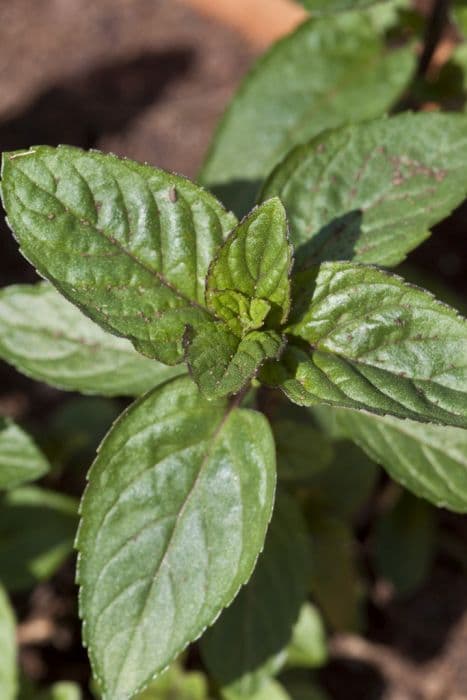Catmint Nepeta racemosa 'Felix'

ABOUT
Nepeta racemosa 'Felix', commonly known as catmint, presents a rounded and mound-like shape. Its foliage is made up of small, aromatic leaves that are gray-green in color and have a soft, fine texture which invites touch. The leaves are typically edged with a slight scallop shape. Throughout the blooming period, catmint produces profuse spikes of tiny, lavender-blue flowers, which densely cluster towards the tips of the stems, creating a cloud of delicate blooms that seem to hover above the foliage. These flowers are known for attracting butterflies, bees, and other pollinators, adding movement and life to the plant's vicinity. Furthermore, the plant exudes a pleasant, herb-like fragrance which can be particularly attractive to feline pets, hence its common name. Catmint's overall appearance is charming and informal, making it a favorite in cottage gardens and borders, where its soothing color palette and graceful form can complement a wide range of other garden plants.
About this plant
 Names
NamesFamily
Lamiaceae
Synonyms
Catmint, Persian Catmint, Blue Nepeta, Raceme Catnip
Common names
Nepeta nervosa, Nepeta mussinii, Glechoma racemosa, Dracocephalum moldavica var. glandulosum.
 Toxicity
ToxicityTo humans
Nepeta racemosa 'Felix', commonly known as catmint, is not considered toxic to humans. Therefore, ingesting parts of this plant is generally not expected to cause poisoning or harmful symptoms.
To pets
Catmint can be appealing to cats due to its mild sedative effect, which is similar to that of catnip. However, it is not considered toxic to pets. While it is generally safe, consuming large amounts may cause mild gastrointestinal upset in some animals. Nonetheless, there are no severe toxic effects associated with catmint ingestion in pets.
 Characteristics
CharacteristicsLife cycle
Perennials
Foliage type
Deciduous
Color of leaves
Green
Flower color
Blue
Height
1-2 feet (30-60 cm)
Spread
1-2 feet (30-60 cm)
Plant type
Herb
Hardiness zones
3-8
Native area
Caucasus
Benefits
 General Benefits
General Benefits- Attracts pollinators: Nepeta racemosa 'Felix', commonly known as Catmint, is known to attract bees, butterflies, and other beneficial insects to gardens.
- Drought tolerance: Catmint is highly adaptable to dry conditions, making it suitable for water-wise landscapes.
- Low maintenance: This plant requires minimal care once established, making it ideal for gardeners seeking low-maintenance options.
- Deer and rabbit resistance: Catmint is resistant to browsing by deer and rabbits, protecting it from wildlife damage.
- Ground cover: With its spreading habit, Catmint can be used effectively as a ground cover to suppress weeds and cover bare spots in the garden.
- Aesthetic appeal: Catmint produces beautiful lavender-blue flowers that add color and visual interest to garden beds and borders.
- Fragrance: The foliage of Catmint is aromatic, and can provide a pleasant fragrance when brushed against or crushed.
- Versatility: This plant can be used in rock gardens, container gardening, or as a border plant, demonstrating great versatility in garden design.
- Long blooming: Catmint has a long flowering period, providing extended color and interest in the landscape.
 Medical Properties
Medical PropertiesThis plant is not used for medical purposes.
 Air-purifying Qualities
Air-purifying QualitiesThis plant is not specifically known for air purifying qualities.
 Other Uses
Other Uses- Nepeta racemosa 'Felix', commonly known as catmint, can be used as a natural pest deterrent in gardens, its aromatic properties are known to repel certain insects and pests.
- The plant can be used in potpourris and sachets; the leaves maintain their fragrance when dried and provide a pleasant aroma.
- Catmint can be planted as a companion plant in vegetable gardens to attract beneficial insects such as bees and butterflies for pollination.
- The essential oil of catmint can be used in home-made natural cleaners, offering a refreshing scent when mixed with other ingredients.
- Dried catmint leaves can be used as a natural stuffing for pet toys, particularly for cats, as an alternative to store-bought catnip.
- Catmint can be used as a decorative element in floral arrangements, adding a touch of greenery with its grayish-green foliage and lavender flowers.
- When planted near paths and walkways, the plant can release its fragrance when brushed against, creating a sensory garden experience.
- The leaves of catmint can be used to create a naturally scented lining for shelves and drawers.
- Some artisanal cheese makers infuse catmint into their cheese for an unusual herbal flavor note.
- Catmint can be added to the compost pile as a green layer to enhance the composting process due to its high nitrogen content.
Interesting Facts
 Feng Shui
Feng ShuiThe Catmint is not used in Feng Shui practice.
 Zodiac Sign Compitability
Zodiac Sign CompitabilityThe Catmint is not used in astrology practice.
 Plant Symbolism
Plant Symbolism- Relaxation: Nepeta racemosa 'Felix', commonly known as Catmint, is often associated with relaxation because of its calming effect on cats, which are known to be attracted to this herb.
- Playfulness: The playful response of cats to Catmint can symbolize a sense of fun and light-heartedness in human life.
- Home and Hearth: Catmint is also a common garden plant, which can symbolize domestic comfort and the simple pleasures of home.
- Healing: With its historical use in herbal remedies, Catmint may carry a symbolic meaning of healing and soothing ailments.
 Water
WaterCatmint 'Felix' prefers consistent moisture but is drought-tolerant once established. During the first growing season, water the plant regularly to help establish a strong root system, about 1 inch per week, either through rainfall or supplemental watering. Adjust to approximately 1 to 1.5 gallons every two weeks for an established plant, and scale back during rainy periods or in cooler months. In hot, dry weather, you might need to water weekly. Be sure to water deeply and directly at the soil level, allowing the soil to dry out somewhat between waterings to discourage root rot.
 Light
LightCatmint 'Felix' thrives in full sun, meaning at least six hours of direct sunlight per day. The best spot for this plant is an area where it can receive unfiltered sunlight throughout the day. However, in regions with very hot summers, Catmint can benefit from some afternoon shade to prevent scorching.
 Temperature
TemperatureCatmint 'Felix' is a hardy perennial capable of withstanding a temperature range from about -30 to 90 degrees Fahrenheit. The ideal temperature for optimal growth is between 60 and 70 degrees Fahrenheit. Always ensure good air circulation to prevent issues at higher temperatures.
 Pruning
PruningCatmint 'Felix' should be pruned to promote bushier growth and more blooms. Cut back heavily in early spring before new growth starts. After the first flush of flowers fades, pruning by one-third can encourage a second bloom. The best time for pruning is after the first flowering, generally in early summer.
 Cleaning
CleaningAs needed
 Soil
SoilCatmint 'Felix' thrives in well-draining soil with a mix of loam, sand, and compost. A pH range of 6.0 to 7.5 is ideal for this plant. Amend with organic matter to improve drainage and aeration.
 Repotting
RepottingCatmint 'Felix' should be repotted every 2-3 years or when it becomes root-bound. Spring is the best time to repot to encourage new growth.
 Humidity & Misting
Humidity & MistingCatmint 'Felix' is tolerant of a wide range of humidity levels and does well in average ambient moisture found in most homes and gardens.
 Suitable locations
Suitable locationsIndoor
Place Catmint 'Felix' in a sunny spot and ensure good air circulation.
Outdoor
Plant Catmint 'Felix' in full sun to partial shade in well-drained soil.
Hardiness zone
3-8 USDA
 Life cycle
Life cycleNepeta racemosa 'Felix', commonly known as Catmint 'Felix', begins its life cycle when seeds are sown in the soil after the last frost in spring. The seeds germinate, leading to the emergence of seedlings, which then develop true leaves and establish a root system. As the plant matures, it undergoes vegetative growth, producing stems and leaves that are aromatic and attract pollinators. During late spring to summer, Catmint 'Felix' reaches the flowering stage, with spikes of lavender to purple flowers that are highly attractive to bees and butterflies. After pollination, the flowers produce seeds that are then dispersed to new locations, thereby completing the reproductive cycle. With proper care and favorable conditions, Catmint 'Felix' can become a perennial, returning year after year through overwintering of its root system.
 Propogation
PropogationPropogation time
Spring-Early Summer
The most popular method of propagating Nepeta racemosa 'Felix', commonly known as the catmint 'Felix', is through division. This is best done in the early spring or early fall, when the plant is not in full bloom. To propagate by division, carefully dig up an established clump of catmint and gently separate it into smaller sections, ensuring each section has a good amount of roots. These sections can then be replanted in well-draining soil at the same depth they were originally growing. Make sure to water the new plantings thoroughly to help establish the root system. This method allows gardeners to quickly and efficiently expand their catmint 'Felix' plantings or share with fellow garden enthusiasts.









